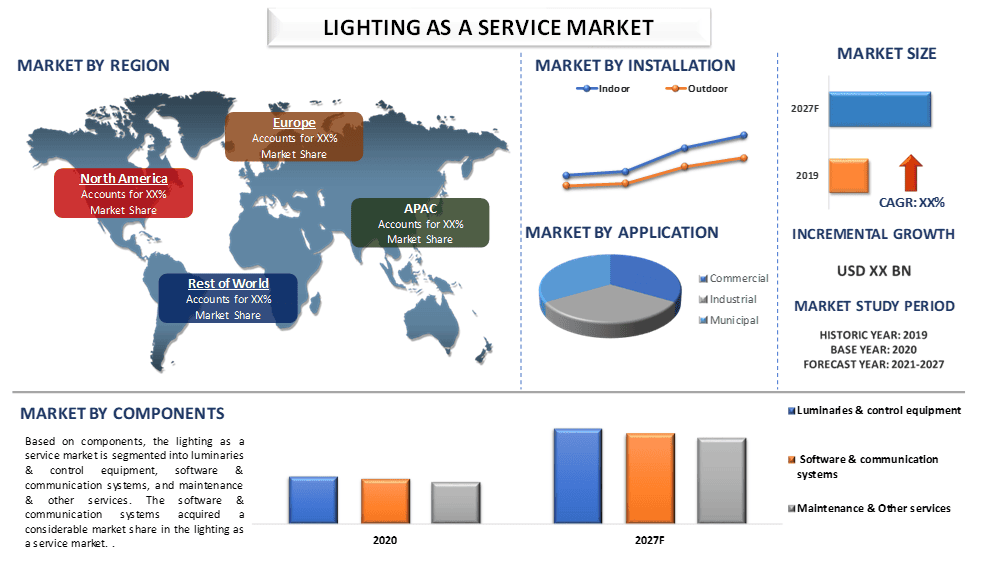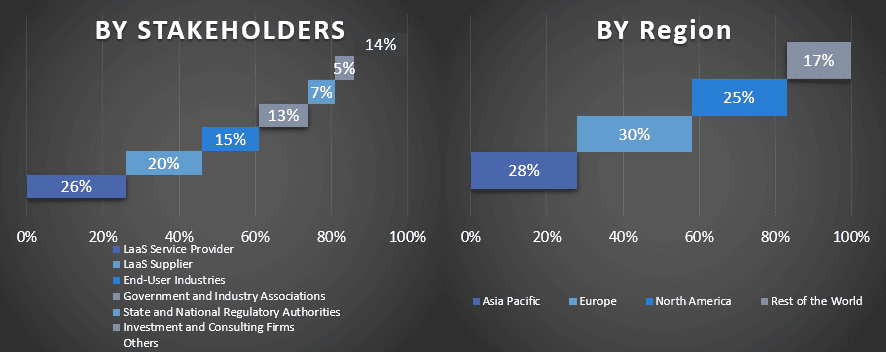ライティング・アズ・ア・サービス市場:現状分析と予測(2021年~2027年)
設置に重点(屋内および屋外);コンポーネント(照明器具および制御機器、ソフトウェアおよび通信システム、メンテナンスおよびその他のサービス);エンドユーザー(商業、工業、および自治体);および地域/国

LaaS (Light as a Service) は、英国を拠点とする Innovate UK という機関から共同出資を受けている 2 年間のプロジェクトです。Lighting as a Service とは、センサーとモノのインターネット (IoT) 技術の助けを借りて、旧式の照明からスマート照明への移行を可能にする、より優れた照明を指し、エンドユーザー側の投資なしにコストを削減し、エネルギー効率を高めます。LaaS の市場規模にプラスの影響を与えている要因としては、持続可能な照明ソリューションへの移行や、エネルギー効率の高い照明技術としての LED の登場などがあります。さらに、新興国全体でのスマートシティの建設の急増も、サービスとしての照明の市場規模を押し上げています。
さらに、Renewable Partnerships などのさまざまな Lighting as a Service プロバイダーは、二酸化炭素排出量を削減するために、関連する投資コストなしで LED 照明ソリューションを提供しており、IoT を含む技術の急速な進歩により、Lighting as a Service 市場の需要がさらに拡大します。
世界の Lighting as a Service 市場は、2021 年から 2027 年にかけて 45 % を超える CAGR を記録すると予想されています。 Lighting as a Service のエンドユーザーの市場規模を惹きつけている要因としては、ユーザーへの直接的な価格設定がないこと、エネルギー消費の最適化、継続的な価値の節約、メンテナンスが不要なこと、知識収集、デバイス間通信、リモート管理などのアドオン機能とシステムがサービスとしての照明 (LaaS) の市場規模を牽引していることが挙げられます。
さらに、サービスとしての照明市場は、エネルギー効率の高い照明システムに対する需要の増加と、エネルギー効率の高いシステムを備えた従来の照明システムを段階的に廃止するためのいくつかの政府からの支援により、世界的に著しい成長を見せています。ただし、サービス指向の照明モデルの価値に対する認識の欠如は、サービスとしての照明市場の成長を妨げると予想されます。
Koninklijke Philips N.V.、General Electric Company、Lunera、Lutron Electronics Co、RCG Lighthouse、Cree Inc.、SIB Lighting、Future Energy Solutions、Eaton Corporation、Digital Lumens などが、市場の主要なプレーヤーです。これらのプレーヤーは、顧客にハイテクで革新的な製品/テクノロジーを提供するために、いくつかの M&A と提携を行ってきました。
レポートで提示される洞察
「設置場所の中で、屋外カテゴリーが 2020 年の市場シェアの大部分を占めました」
設置場所に基づいて、サービスとしての照明市場は屋内と屋外に二分されます。屋外セグメントは、サービスとしての照明市場で広範な市場シェアに対応しています。これは主に、地方自治体が提供するオープンな公共スペース、道路、橋、公共駐車場、歩道、高速道路などの照明が市場を牽引していることに起因しています。
「コンポーネントの中で、ソフトウェア & 通信システムは予測期間中に最も高い CAGR を記録すると予想されます」
コンポーネントに基づいて、サービスとしての照明市場は、照明器具 & 制御機器、ソフトウェア & 通信システム、およびメンテナンス & その他のサービスにセグメント化されています。ソフトウェア & 通信システムは、サービスとしての照明市場でかなりの市場シェアを獲得しました。これは主に、IoT と LaaS の組み合わせにより、職場での照明と温度の制御、照明の使用パターンの追跡、不要な場合の削減、建物の二酸化炭素排出量を大幅に削減するなど、さまざまな施設をユーザーに提供することに関係しています。
「エンドユーザーに基づいて、商業セグメントは予測期間中に広範な CAGR を記録すると予想されます」
エンドユーザーに基づいて、サービスとしての照明市場は、商業、産業、および自治体に分類されます。商業セグメントは、サービスとしての照明市場のかなりのシェアに対応しており、予測期間中に高い成長を遂げると予想されます。これは主に、経済成長という重要な構造的影響によるものです。さらに、商業消費者は、サービスとしての照明を通じてエネルギー効率にアクセスできるようになり、それが今度は、複数の用途でのエネルギー消費の改善に役立ちます。
「北米は予測期間中に著しい成長を遂げると予想されます」
北米は、サービスとしての照明市場で広範な市場シェアを獲得しており、主に従来の照明システムをエネルギー効率の高い照明システムに置き換えるための政府の支援により、広範な速度で成長すると予想されています。さらに、米国の大規模な倉庫や生産ユニットによる省エネ照明ソリューションの需要の高まりにより、LaaS の導入がエスカレートしています。
さらに、北米では、LaaS にはコスト削減の可能性があり、世界中でエネルギー消費量を削減できるため、商業発売の需要の増加によって、サービスとしての照明市場が牽引されています。たとえば、American Council for an Energy-Efficient Economy によると、これらの施設は米国で消費されるエネルギーの約 19% を占めています。 商業ビルで使用されるエネルギーの半分以上が暖房と照明に使用されています。
このレポートを購入する理由:
- この調査には、認証済みの主要な業界専門家によって検証された市場規模の評価と予測分析が含まれています。
- このレポートは、業界全体のパフォーマンスの概要を一目で示しています。
- このレポートでは、主要なビジネス財務、製品ポートフォリオ、拡張戦略、最近の開発に重点を置いて、著名な業界の同業他社の詳細な分析を取り上げています。
- 業界で蔓延している推進要因、制約、主要な傾向、機会の詳細な調査。
- この調査では、さまざまなセグメントにわたる市場を包括的にカバーしています。
- 業界の地域レベルの詳細な分析。
カスタマイズオプション:
Global Lighting as a Service 市場は、要件またはその他の市場セグメントに応じてさらにカスタマイズできます。これに加えて、UMI は、お客様独自のビジネスニーズがある可能性があることを理解しているため、お客様の要件に完全に適合するレポートを入手するためにお気軽にお問い合わせください。
目次
世界のLighting as a Service市場分析(2021年~2027年)の調査方法
世界のLighting as a Service市場の過去の市場を分析し、現在の市場を推定し、将来の市場を予測することは、世界の主要地域におけるLighting as a Serviceの導入状況を作成および分析するために実施された3つの主要なステップでした。過去の市場規模を収集し、現在の市場規模を推定するために、徹底的な二次調査が実施されました。次に、これらの洞察を検証するために、多数の調査結果と仮定が考慮されました。さらに、世界のLighting as a Service市場のバリューチェーン全体にわたる業界の専門家との徹底的な一次インタビューも実施されました。一次インタビューを通じて市場規模の仮定と検証を行った後、完全な市場規模を予測するためにトップダウン/ボトムアップアプローチを採用しました。その後、業界のセグメントおよびサブセグメントの市場規模を推定および分析するために、市場分解およびデータ三角測量法を採用しました。詳細な方法論を以下に説明します。
過去の市場規模の分析
ステップ1:二次情報源の詳細な調査:
年次報告書および財務諸表、業績プレゼンテーション、プレスリリースなどの企業内部情報源、およびジャーナル、ニュースおよび記事、政府刊行物、競合他社の刊行物、セクターレポート、サードパーティのデータベース、その他の信頼できる刊行物などの外部情報源を通じて、Lighting as a Service市場の過去の市場規模を入手するために、詳細な二次調査を実施しました。
ステップ2:市場セグメンテーション:
Lighting as a Service市場の過去の市場規模を入手した後、主要地域におけるさまざまなセグメントおよびサブセグメントの過去の市場に関する洞察とシェアを収集するために、詳細な二次分析を実施しました。レポートに含まれる主要セグメントは、設置、コンポーネント、エンドユーザーなどです。さらに、その地域におけるテストモデルの全体的な導入状況を評価するために、国レベルの分析を実施しました。
ステップ3:要因分析:
さまざまなセグメントおよびサブセグメントの過去の市場規模を取得した後、Lighting as a Service市場の現在の市場規模を推定するために、詳細な要因分析を実施しました。さらに、Lighting as a Serviceのさまざまな設置、コンポーネント、エンドユーザーなどの従属変数と独立変数を使用して、要因分析を実施しました。世界のLighting as a Service市場セクターにおけるトップパートナーシップ、合併および買収、事業拡大、製品発売を考慮して、需要と供給側のシナリオについて徹底的な分析を実施しました。
現在の市場規模の推定と予測
現在の市場規模の算定:上記の3つのステップからの実行可能な洞察に基づいて、現在の市場規模、世界のLighting as a Service市場における主要なプレーヤー、およびセグメントの市場シェアに到達しました。必要なすべてのパーセンテージシェアの分割と市場分解は、上記の二次的なアプローチを使用して決定され、一次インタビューを通じて検証されました。
推定と予測:市場の推定と予測では、ドライバーとトレンド、制約、および関係者が利用できる機会を含むさまざまな要因に重みが割り当てられました。これらの要因を分析した後、関連する予測手法、つまりトップダウン/ボトムアップアプローチを適用して、世界の主要市場全体におけるさまざまなセグメントおよびサブセグメントについて、2027年頃の市場予測に到達しました。市場規模の推定に採用された調査方法論には、以下が含まれます。
- 収益(米ドル)の観点からの業界の市場規模、および国内の主要市場全体におけるLighting as a Service市場の導入率
- 市場セグメントおよびサブセグメントのすべてのパーセンテージシェア、分割、および分解
- 提供されるソリューションの観点から見た、世界のLighting as a Service市場における主要なプレーヤー。また、急速に成長している市場で競争するためにこれらのプレーヤーが採用している成長戦略
市場規模とシェアの検証
一次調査:主要地域全体におけるトップレベルのエグゼクティブ(CXO/VP、営業責任者、マーケティング責任者、オペレーション責任者、地域責任者、国責任者など)を含む主要なオピニオンリーダー(KOL)との詳細なインタビューを実施しました。次に、一次調査の結果を要約し、述べられた仮説を証明するために統計分析を実行しました。一次調査からのインプットは二次的な調査結果と統合され、それによって情報が実行可能な洞察に変わりました。
さまざまな地域における一次参加者の分割

市場エンジニアリング
データ三角測量技術を採用して、全体的な市場推定を完了し、世界のLighting as a Service市場の各セグメントおよびサブセグメントの正確な統計数値に到達しました。データは、世界のLighting as a Service市場における設置、コンポーネント、およびエンドユーザーの分野におけるさまざまなパラメーターとトレンドを調査した後、いくつかのセグメントおよびサブセグメントに分割されました。
世界のLighting as a Service市場調査の主な目的
世界のLighting as a Service市場の現在および将来の市場トレンドは、調査で正確に指摘されました。投資家は、調査で実施された定性的および定量的分析に基づいて、投資に関する判断を下すための戦略的な洞察を得ることができます。現在および将来の市場トレンドは、地域レベルでの市場の全体的な魅力を決定し、業界の参加者が未開拓の市場を開拓して、先行者利益を享受するためのプラットフォームを提供します。調査のその他の定量的な目標には、以下が含まれます。
- 金額(米ドル)の観点から見た、Lighting as a Service市場の現在および予測される市場規模を分析します。また、さまざまなセグメントおよびサブセグメントの現在および予測される市場規模を分析します
- 調査のセグメントには、設置、コンポーネント、およびエンドユーザーの分野が含まれます。
- Lighting as a Service市場業界の規制フレームワークの定義と分析。
- さまざまな仲介業者の存在に伴うバリューチェーンの分析と、業界の顧客および競合他社の行動の分析。
- 主要地域におけるLighting as a Service市場の現在および予測される市場規模の分析。
- レポートで調査された地域の主要国には、アジア太平洋、ヨーロッパ、北米、およびその他の地域が含まれます。
- Lighting as a Service市場の企業プロファイルと、急速に成長している市場で生き残るために市場プレーヤーが採用している成長戦略
- 業界の詳細な地域レベルの分析
関連 レポート
この商品を購入したお客様はこれも購入しました










